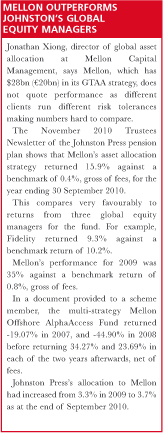Volatile markets have been kind to dynamic asset allocation managers, finds Nick Fitzpatrick. Managers say if macro issues continue to dominate investment decisions, they will see more gains in both returns and business development. But are some basking in the afterglow of one good market call?
A number of managers with asset allocation strategies – such as dynamic asset allocation (DAA), multi-asset or global tactical asset allocation (GTAA) – have produced notable returns, typically over a cash benchmark.
They claim there is now more pension fund demand for asset allocation strategies as plan sponsors and trustees continue to worry about volatility. After UK newspaper publisher Johnston Press’ pension scheme gained 15.5% in relative performance from its asset allocation portfolio, and since the £16bn (€19bn) Barclays UK Pension Fund appointed its own head of DAA several months ago, there is some evidence to back these claims.
This fresh lustre for asset allocators will be welcomed. Many experienced less than impressive returns during the pre-recession bull market as they failed to distinguish their multi-asset returns from the high gains of equity managers. Then, after the Lehman Brothers collapse in 2008, correlation between assets hampered their efforts to add value, achieved by rotating between asset classes to benefit from any price gains, and limiting downside from falling assets.
Scott Wolle is CIO global asset allocation at Invesco. “It would be difficult for any diversified strategy to keep up with equity managers in an equity bull market, although the risk in a diversified portfolio would be considerably less,” he says.
But will dynamic asset allocation-type strategies enjoy good relative performance beyond this period? While macro-thinking dominates investment decision-making, managers say they will.
Volatility and beyond
“Right now, and probably for the next couple of years, this market is driven by macro issues such as fiscal direction. So more and more you will see demand for asset allocation to deal with the challenges created by these problems,” says Jonathan Xiong, global investment strategist at Mellon Capital Management, which runs the asset allocation strategy for the Johnston Press pension scheme.
Johanna Kyrklund, head of UK multi-asset investment at Schroders, says: “I think macro-economic volatility will continue to stick around, and this will offer opportunities for dynamic asset allocation strategies.”
Wolle adds: “Some dynamic asset allocation managers will do things differently, but we operate from a macro perspective, and there are still many macro risks facing investors.”
There is also a regulatory driver in the form of Solvency II, the capital adequacy regulation for insurance companies.
Elodie Laugel, head of financial engineering at Axa Investment Managers, says Solvency II will require a more dynamic approach to the asset management of insurance companies’ investment portfolios as they try to limit their financial risk in the stricter solvency regime (see separate article on Solvency II in February 2011 issue).
The difference between dynamic and global tactical asset allocation is principally one of timeframes for decision-making and action, but both strategies aim to react to changing markets in a much shorter time frame than pension funds have traditionally been able to.
Some managers rotate real assets, while some use a derivative overlay to increase or reduce exposure. By doing this, asset allocation managers should be able to make the most of market dislocation, which inevitably occurs over a pension fund’s long investment horizon.
Pension fund boards, fund managers say, are ill-equipped to do this themselves as decision-making processes can often take too much time.
“Investors often deviate from the efficient frontier portfolio with static asset allocation policies, which implies stale expectations,” says Xiong of Mellon.
“Often institutional investors are too large or do not have the in-house resources to shift asset allocation mixes. They select managers to do this for them. But if you look at whether it’s about selecting the right manager or about the right asset allocation in order to achieve that, then we believe being in the right asset class is more critical to achieving optimal portfolio returns.”
Volatility has provided opportunities lately that have not been seen for some time. But critics will say that some asset allocators need longer to prove themselves. After all, the memory of poorly performing balanced funds, which in some ways were forerunners to multi-asset investing, still resonates.
Nick Sykes, a director at Mercer Investment Consulting, says: “The experience of pension funds with balanced managers in past market crashes was that the industry as a whole made poor decisions about when to get out of equities and into bonds. They did not move soon enough, tending to follow the equity market up, rather than reducing exposure to the market as it rose. They followed rather than led.”
“We think the decision between equities, bonds and property is a hard one to make and even harder to get right consistently,” he adds.
And remember, he says, this decision has to be right not just once, but twice – that’s when to exit the asset class, and when to re-enter it.
Ben Clissold, deputy CIO at P-Solve, a consulting firm which also runs a DAA strategy within a fiduciary service, says: “These strategies have to be dynamic. Traditional balanced strategies moved money around but only at the edges, which doesn’t make much difference. A proper DAA manager will move more decisively from, say, 20% to 60% in equities.”
Acknowledging that AllianceBernstein has a recent fund launch in the DAA space, Patrick Rudden, the firm’s head of blend strategies, sounds a note of caution about funds or managers with a short track record.
“There have been two bear markets in the past decade. Those strategies that have been around three to four years may have just got one market call right, but you should not bet the ranch on them.”
AllianceBernstein launched a Luxembourg-domiciled Asia Global Balanced fund in April last year, which has the firm’s DAA strategy embedded within it, says Rudden.
The DAA strategy is used by much of AllianceBernstein’s private client base in the US and embedded in retail target-date funds, too. AllianceBernstein also runs DAA money for US insurers’ variable annuities businesses and is seeing interest from European wealth managers in the strategy.
Rudden points out that the emphasis is on risk rather than returns. “The fit for this product is for those who want us to forecast risk rather than forecast return. Its about dynamic risk management,” he says.
The strategy uses a derivatives overlay to adjust exposure to cash, equities, bonds and property. Rudden says commodities and hedge funds could be incorporated in the DAA strategy depending on the outcome of current research. The underlying assets amount to around €15bn.
Invesco launched a dynamic asset allocation strategy in 2008 that attempts to balance how much risk is taken depending on economic outcomes such as inflation and growth. Exposure, meanwhile, is achieved through futures.
This approach, coupled with the cash+ benchmark, makes the strategy essentially similar to the global macro strategy used by hedge funds. Global macro is often seen as a competitor to DAA, but distinguishing factors, says Wolle, are the greater transparency in DAA strategies, greater liquidity, and the lower fees that stem from the beta returns of DAA exposure to broad asset classes – ie, beta.


Asset allocation
Schroders has three different vehicles in its GTAA strategy, with total assets of £104.3m, as at 31 December 2010. The strategy was launched in January 2008 with seed capital. A pooled fund, a UK Unit Trust called the Schroder Global Asset Allocation Fund, was launched in April 2009.
The composite excess return of Schroders’ global asset allocation strategy was 5.9% against Libor between January 2008 and 31 December 2010.
Baring Asset Management has £2.8bn (€3.32bn) under management (as at 30 June 2010) in its dynamic asset allocation fund. Percival Stanion is Baring’s head of multi-asset and strategic asset allocation. He says since the strategy’s inception at 16 January 2007, it has seen a compound annualised return of 8.2% compared with a Libor+ 400 benchmark return of 7.5%.
Over the past twelve months, the return was 10.3% against a 4.8% benchmark return, and over three years, it was 7.8% against a 6.6% benchmark return.
However, Stanion points out that the fund lost 5% in 2008. In the key year of the credit crunch, the fund had reduced its equity exposure to 15% by the summer and invested more in gold bullion and bonds, but the effects of Lehman’s collapse on 15 September were still felt.
Stanion goes on to say that the fund invests in any publicly traded investment across equities, bonds, commodities and commercial property, even timber funds and infrastructure funds.
“We build portfolios starting with ten-year strategic modelling to try and understand what the long-term return priority is for a given asset,” he says.
A tactical asset allocation process is then applied to the model.
“It is akin to what consultants do for pension funds doing asset-liability management,” adds Stanion.
©2011 funds europe





